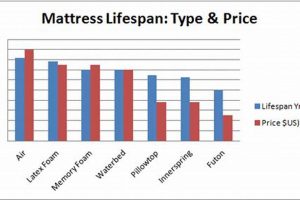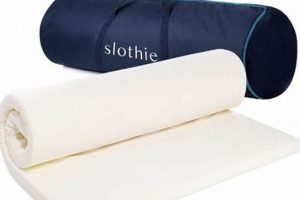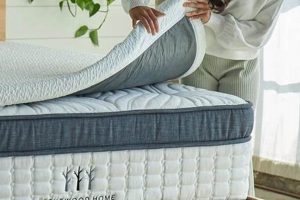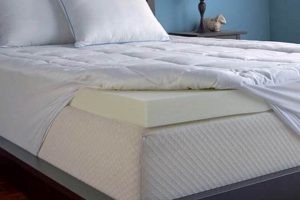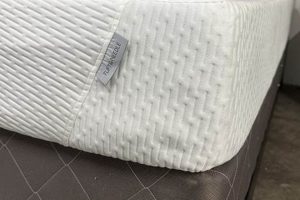The time required for a viscoelastic foam mattress to reach its full dimensions after being unpacked is a crucial factor in the overall customer experience. This period, often ranging from a few hours to several days, is influenced by several variables related to the mattress’s construction and environmental conditions. For instance, a tightly compressed mattress may require a longer duration to fully regain its original shape compared to one less densely packaged.
Proper expansion directly impacts the comfort and support the mattress provides. Incomplete expansion can lead to uneven surfaces and diminished support, ultimately affecting sleep quality. Understanding the typical duration involved and factors affecting it, such as ambient temperature and humidity, allows consumers to optimize the setup process and ensure they receive the full benefits of their purchase. The development of compression and packaging techniques has continually sought to minimize this wait time while preserving the integrity of the mattress.
This article will delve into the various factors affecting the duration of expansion, providing practical guidance on how to expedite the process and what to expect during the initial hours and days after unboxing a memory foam mattress. It will also address common issues encountered during expansion and their potential resolutions.
Optimizing Mattress Expansion
To ensure optimal performance and comfort, proper expansion of a viscoelastic foam mattress is essential. The following tips are designed to assist in maximizing expansion efficiency and addressing potential issues.
Tip 1: Unpack Promptly. The mattress should be removed from its packaging as soon as possible after delivery. Prolonged compression can hinder complete expansion.
Tip 2: Provide Adequate Ventilation. Unpacking in a well-ventilated room is crucial. Adequate airflow facilitates the dissipation of volatile organic compounds (VOCs) and promotes quicker expansion.
Tip 3: Maintain a Suitable Room Temperature. Lower temperatures can impede expansion. A room temperature between 68-72F (20-22C) is generally optimal.
Tip 4: Allow Sufficient Time. Though some mattresses may partially expand within hours, full expansion can take up to 72 hours or longer. Patience is necessary to achieve the intended firmness and support.
Tip 5: Rotate the Mattress. Rotating the mattress periodically during the expansion phase can assist in even distribution and prevent localized compression issues.
Tip 6: Monitor for Uneven Expansion. Inspect the mattress for any areas that are not expanding properly. Gently massage or apply slight pressure to those areas to encourage expansion.
These measures can significantly improve the expansion process and contribute to a comfortable and supportive sleep surface.
The subsequent sections of this document will provide further detail on troubleshooting common expansion-related problems and ensuring long-term mattress performance.
1. Foam Density
Foam density, measured in pounds per cubic foot (lbs/ft), is a primary determinant of the expansion duration of a viscoelastic mattress. This characteristic influences not only the mattress’s overall feel and support but also the time it takes to achieve its intended shape after compression.
- Impact on Compression
Higher density foams, due to their increased material concentration, are compressed more tightly during packaging. This greater degree of compression subsequently increases the time required for the foam cells to recover and fully expand to their original dimensions. Mattresses with lower density foams generally expand more rapidly because the compression is less extreme.
- Cell Structure Recovery
The cell structure within memory foam must rebound after being subjected to compression. Denser foams possess a more intricate and compact cell structure, requiring more time for each cell to fully inflate and regain its shape. This process is analogous to inflating a balloon with thicker walls, which requires more effort and time.
- Influence of Airflow
Foam density directly affects airflow within the mattress. Denser foams have reduced air circulation, which can slow down the expansion process. Air must permeate the foam to facilitate the recovery of compressed cells. Lower density foams allow for better airflow, thereby accelerating expansion.
- Long-Term Performance
While higher density foams may take longer to expand initially, they typically exhibit greater durability and resistance to compression over time. This relationship suggests a trade-off between initial expansion time and long-term mattress performance. Consumers should consider their priorities regarding these factors when selecting a memory foam mattress.
In summation, foam density exerts a significant influence on the expansion duration of viscoelastic mattresses. The degree of compression, cell structure recovery, and airflow are all directly affected by foam density, ultimately determining the amount of time required for a mattress to reach its intended shape and deliver its designed level of comfort and support. Consideration of foam density is therefore critical in predicting and managing the expansion process.
2. Ambient Temperature
Ambient temperature plays a crucial role in the expansion rate of a memory foam mattress. Viscoelastic foam is temperature-sensitive, and its physical properties are directly affected by the surrounding environment. Understanding this relationship is essential for consumers seeking to optimize the mattress unboxing and setup process.
- Molecular Mobility
At higher temperatures, the molecules within the memory foam exhibit increased kinetic energy, leading to greater mobility. This enhanced molecular motion facilitates the foam’s ability to return to its original shape after compression. Conversely, lower temperatures reduce molecular mobility, thus slowing down the expansion process. The material’s elasticity and flexibility are directly influenced by temperature, affecting its ability to decompress effectively.
- Gas Expansion within the Foam
Memory foam contains trapped gases, often air, that contribute to its structure and support. Warmer temperatures cause these gases to expand, which assists in the inflation of the foam cells. Conversely, cooler temperatures cause the gases to contract, hindering cell expansion. This phenomenon is particularly relevant in mattresses that have been tightly compressed for shipping.
- Impact on Viscosity
Viscosity, a measure of a fluid’s resistance to flow, is temperature-dependent in memory foam. Higher temperatur
es reduce the viscosity of the foam, making it more pliable and responsive to expansion forces. Lower temperatures increase viscosity, rendering the foam more rigid and resistant to deformation. This directly influences the time required for the mattress to achieve its intended firmness and shape. - Optimal Temperature Range
The ideal temperature range for memory foam mattress expansion is typically between 68F (20C) and 72F (22C). Temperatures significantly outside this range can either hinder or accelerate the expansion process in an undesirable manner. Extreme heat may cause premature degradation of the foam, while extreme cold can render it excessively firm and slow to expand. Maintaining the recommended temperature range is crucial for ensuring complete and even expansion.
In summary, ambient temperature exerts a profound influence on the expansion behavior of a viscoelastic mattress. Molecular mobility, gas expansion, and viscosity are all temperature-dependent factors that directly impact the rate at which the foam recovers its shape after compression. Therefore, controlling the surrounding temperature within the specified range is an essential step in optimizing the unboxing and setup process and ensuring the long-term performance of the mattress.
3. Manufacturing Process
The procedures employed during the creation of viscoelastic foam mattresses significantly influence the duration required for them to fully expand after unboxing. Variations in these processes can alter the foam’s cell structure, density, and overall responsiveness, thereby impacting the time it takes to regain its intended shape.
- Curing and Off-Gassing
The curing stage, where the foam solidifies and stabilizes, plays a critical role. Insufficient curing can lead to increased off-gassing of volatile organic compounds (VOCs) after packaging, potentially hindering expansion by disrupting the foam’s structural integrity. Conversely, prolonged curing may result in a more rigid foam that requires additional time to fully rebound from compression. Proper ventilation during curing is also essential to remove excess chemicals and moisture, which can otherwise impede the expansion process.
- Cell Structure Formation
The method used to create the foam’s cell structure, whether through open-cell or closed-cell technology, affects its compressibility and recovery rate. Open-cell foams, characterized by interconnected air pockets, tend to expand more quickly due to enhanced airflow. Closed-cell foams, with isolated air pockets, may exhibit slower expansion as air circulation is restricted. The specific chemical agents and blowing agents used in the foaming process also contribute to the size and distribution of cells, influencing the speed and completeness of expansion.
- Compression Packaging Techniques
The manner in which the mattress is compressed and packaged for shipping directly affects expansion time. High-pressure compression, while minimizing shipping volume, can lead to greater deformation of the foam’s cell structure, prolonging the recovery period. Additionally, the duration for which the mattress remains compressed impacts its ability to fully rebound. Mattresses that are compressed for extended periods often require more time to expand compared to those packaged shortly before shipment. The materials used for packaging, such as airtight plastic wraps, can also influence the rate of off-gassing and expansion by affecting ventilation.
- Quality Control Standards
Strict adherence to quality control standards throughout the manufacturing process is paramount in ensuring consistent and predictable expansion behavior. Quality control measures encompass monitoring foam density, cell structure uniformity, and chemical composition. Regular testing of sample mattresses under controlled conditions can identify potential issues related to expansion. Mattresses that fail to meet established quality criteria may exhibit prolonged expansion times, uneven expansion, or other performance deficiencies. Implementation of robust quality control protocols minimizes these risks and ensures a more reliable product.
In conclusion, the manufacturing processes employed in the production of viscoelastic foam mattresses exert a significant influence on their expansion characteristics. Factors such as curing and off-gassing, cell structure formation, compression packaging techniques, and quality control standards all contribute to the time required for a mattress to fully expand after unboxing. Optimizing these processes is essential for minimizing expansion time and ensuring optimal product performance.
4. Compression Rate
The compression rate, defined as the degree to which a memory foam mattress is compacted for packaging and transport, directly influences the time needed for it to fully expand post-unboxing. A higher compression rate implies a greater reduction in volume, leading to more significant deformation of the foam’s cell structure. This deformation necessitates a longer period for the cells to regain their original shape and for the mattress to achieve its intended dimensions. For example, a mattress compressed to 25% of its original thickness will invariably require more time to expand than one compressed to 50%.
The relationship between compression rate and expansion time is not linear; above a certain threshold, the expansion time increases disproportionately. This is because extreme compression can cause micro-tears or structural damage within the foam, which further inhibits its ability to recover. Manufacturers carefully balance the compression rate to minimize shipping costs while ensuring that the mattress can reasonably expand within a timeframe acceptable to consumers. The choice of packaging materials, such as high-strength plastics, also plays a role in maintaining the compressed state and preventing premature or uneven expansion during transit.
Understanding the impact of compression rate is crucial for both manufacturers and consumers. Manufacturers can optimize their packaging processes to minimize expansion time, thereby enhancing customer satisfaction. Consumers, on the other hand, should be aware that mattresses with higher compression rates may require a longer waiting period before they can be used comfortably. Additionally, factors like ambient temperature and humidity can interact with the compression rate to further influence the expansion process. Thus, a comprehensive understanding of these variables is essential for managing expectations and ensuring optimal mattress performance.
5. Ventilation Sufficiency
Ventilation sufficiency is a critical factor influencing the duration required for a memory foam mattress to fully expand. Adequate airflow facilitates off-gassing, regulates temperature, and promotes uniform expansion throughout the mattress’s structure.
- Off-Gassing Facilitation
Memory foam mattresses often emit volatile organic compounds (VOCs) after being unpacked. Adequate ventilation allows these gases to dissipate more rapidly, preventing them from hinderin
g the foam’s expansion process. Insufficient ventilation can trap VOCs, potentially slowing down the full recovery of the mattress’s intended shape and firmness. A real-world example includes a mattress unboxed in a small, enclosed room experiencing significantly slower expansion compared to an identical mattress unboxed in a larger, well-ventilated space. - Temperature Regulation
Ventilation helps regulate the temperature within the mattress, which, as previously discussed, impacts the foam’s flexibility and expansion rate. Sufficient airflow prevents the mattress from overheating or becoming excessively cool, maintaining an optimal temperature range for expansion. Mattresses placed on poorly ventilated surfaces, such as solid platforms without adequate spacing, may experience temperature imbalances that impede uniform expansion.
- Moisture Dissipation
Ventilation aids in the dissipation of moisture absorbed during manufacturing or accumulated during shipping. Excessive moisture can hinder expansion by increasing the density of the foam and restricting cell movement. A mattress stored in a humid environment prior to unboxing will require more ventilation to facilitate moisture evaporation, thereby promoting efficient expansion.
- Uniform Expansion Promotion
Proper ventilation ensures that all areas of the mattress expand evenly. Insufficient airflow to certain sections can result in localized compression or uneven surfaces. For instance, a mattress placed against a wall immediately after unboxing may experience restricted airflow on one side, leading to uneven expansion and potentially affecting the overall comfort and support provided by the mattress.
The various facets of ventilation sufficiency ultimately contribute to the overall duration required for a memory foam mattress to achieve its intended shape and firmness. By ensuring adequate airflow, consumers can mitigate potential issues related to off-gassing, temperature regulation, moisture dissipation, and uneven expansion, leading to a more satisfactory product experience.
Frequently Asked Questions
The following section addresses common inquiries regarding the expansion process of viscoelastic foam mattresses, providing clarity on factors influencing the duration and potential issues that may arise.
Question 1: What is the typical timeframe required for a memory foam mattress to fully expand?
The expansion period typically ranges from 24 to 72 hours, contingent upon factors such as foam density, ambient temperature, and the duration of compression during shipping. Certain mattresses may require up to a week for complete expansion, particularly if exposed to colder temperatures or high humidity.
Question 2: Can the expansion duration be accelerated?
Optimizing ambient temperature to within 68-72F (20-22C) and ensuring adequate ventilation can expedite the process. Removing all packaging materials immediately after delivery and allowing the mattress to rest on a flat, well-ventilated surface are also beneficial.
Question 3: What are the potential consequences of using a memory foam mattress before it is fully expanded?
Premature use can lead to uneven support, reduced comfort, and potential long-term deformation of the foam. It is advisable to allow the mattress to fully expand to ensure optimal performance and longevity.
Question 4: Is the presence of a chemical odor upon unboxing a cause for concern?
A mild chemical odor, often referred to as “off-gassing,” is common with new memory foam mattresses. This odor typically dissipates within a few days with proper ventilation. However, persistent or strong odors may indicate a need for further investigation or consultation with the manufacturer.
Question 5: How does foam density affect the expansion rate?
Higher-density foams generally require more time to expand due to their greater material concentration and tighter cell structure. Lower-density foams, conversely, tend to expand more rapidly.
Question 6: What steps should be taken if a mattress fails to fully expand after the recommended timeframe?
Ensure that the mattress is placed in a well-ventilated room with an appropriate temperature. Inspect the mattress for any areas where expansion is visibly restricted. Contacting the manufacturer or retailer for guidance or potential warranty claims is advisable if expansion remains incomplete.
These FAQs provide essential information regarding the expansion process of memory foam mattresses. Understanding these factors allows consumers to effectively manage the setup and ensure optimal product performance.
The following section will provide some concluding remarks and general best practices.
Memory Foam Mattress Expansion
The duration required for a memory foam mattress how long to expand represents a confluence of factors encompassing material science, environmental conditions, and manufacturing processes. This article has explored the impact of foam density, ambient temperature, manufacturing techniques, compression rate, and ventilation sufficiency on the expansion timeline. Understanding these elements allows for informed decision-making and realistic expectation management concerning mattress setup.
Ensuring proper expansion is paramount for realizing the intended comfort and support characteristics of a viscoelastic mattress. Continued advancements in foam technology and packaging methods aim to reduce expansion times and enhance overall product performance. Further research into optimal expansion conditions will contribute to improved consumer satisfaction and minimize potential challenges associated with mattress setup. Consistent adherence to recommended guidelines represents a proactive measure in maximizing the benefits and longevity of memory foam mattresses.


